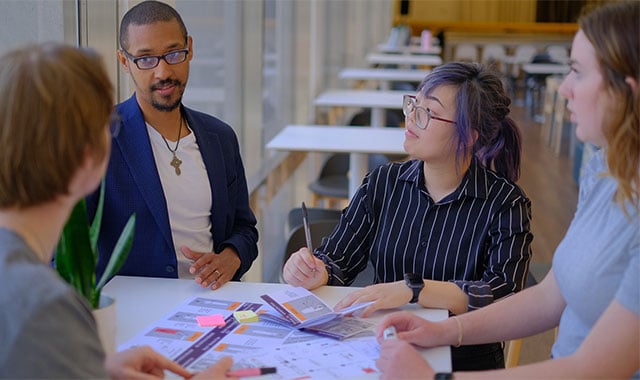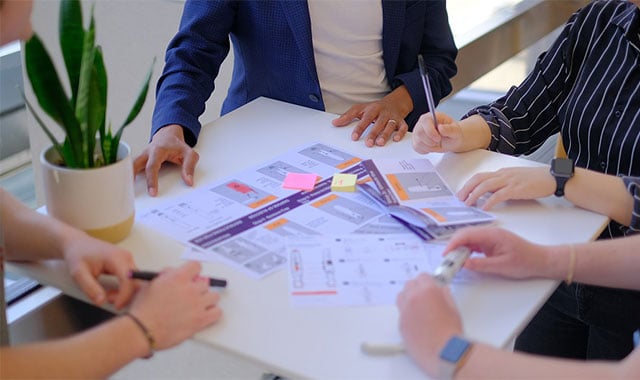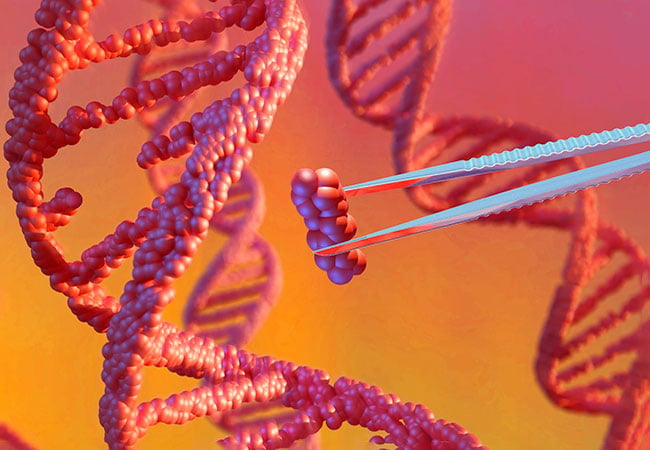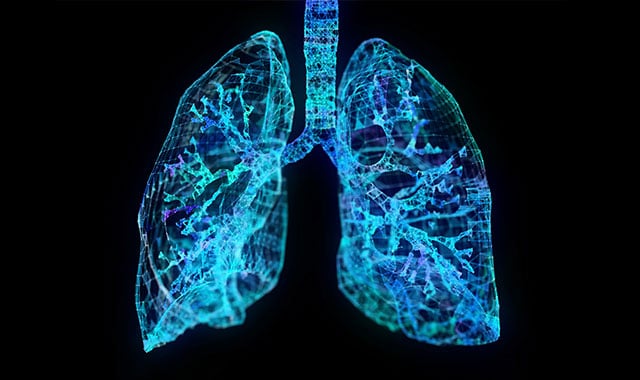Bridging Human Expertise and AI: The Future Is Here
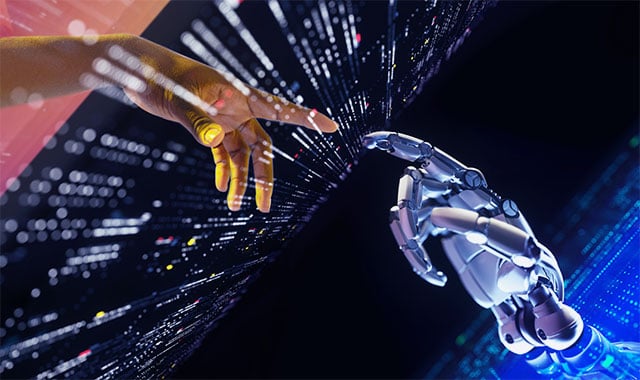
An interview with Justin Sanchez, Ph.D., Battelle Technical Fellow
What comes to mind when you think about the future of human-AI teaming? You might envision robotic arms on a manufacturing assembly line or aiding in precision surgeries. Maybe you think of an algorithm trained to quickly analyze data and predict adverse patient events, providing medical staff time to intervene.
The scope extends far beyond these applications, and the possibilities continue to expand. Every day, groundbreaking research is being conducted to unlock new synergies between human expertise and the power of artificial intelligence.
Justin Sanchez, Ph.D., Battelle Technical Fellow, who leads scientific advancement across life science portfolios including medical devices, pharmaceutical research, biosecurity, and public health, is sharing his insights on what’s on the horizon for human-AI teaming. Justin has published over 100 peer-reviewed papers, authored two books on the design of neurotechnology and holds nine patents.
What's Next for Humans and AI
Question: How do you see the collaboration between humans and AI transforming technology over the next few years?
Justin: AI will still be viewed as an assistant.
Artificial intelligence will still be seen as a partner in problem-solving, helping in areas where individuals or teams may lack efficiency. The problems today’s researchers are trying to solve are extremely complex and require the processing of diverse, interconnected information that is outside our ability to efficiently decipher and manage.
Humans are already relying on AI to lighten the load of many day-to-day tasks. In the health field, this may look like leveraging robotics to provide physical precision during surgery or using algorithms to expedite circuit design.
Although AI has been and will continue to be a powerful partner, it is based on the corpus of all previously generated human works. There will still be a need for creative individuals to contribute to that body of work, giving AI more to explore.
Human intervention and infrastructure, laboratories, equipment, expert human validation, and advanced facilities will continue to play a crucial role in the effective use and implementation of AI.
Advancing Medical Technology
Question: What are some of the most significant advancements in medical technology you predict in human-AI teaming?
Justin: AI will have a significant impact on drug discovery and delivery.
Autoinjectors and other drug delivery systems are traditionally designed considering the properties of the substance being injected. However, new drugs with high viscosity pose a significant challenge for these traditional injectors due to difficulties in manipulating the fluid for delivery at the right rate to specific body areas.
An AI system knowledgeable in fluid mechanics and engineering principles such as stress, strain, and friction could propose innovative designs or new component combinations that may not have been considered by humans. These designs are then tested for functionality, and based on the results, they are either further developed or revised.
This approach could lead to groundbreaking designs for administering hard-to-deliver viscous drugs. However, human expertise remains crucial in assembling prototypes, testing, verifying the design, and making necessary revisions
The application of AI extends beyond just pumps and injectors. It is increasingly being used to predict new opportunities and formulations in drug development. Currently, many drug manufacturers work with standard molecules and try to combine them in a process that can be time-consuming and linear to see if these molecules interact as expected.
Now, many drug developers are inputting all known information about these molecules into an AI system. The AI then generates variants of these molecules that might not have been considered intuitively, unveiling new potential molecule combinations with unique properties.
However, these combinations still need to be validated in a lab. This is where our experts at Battelle come in, with laboratories and specialized equipment to verify these predictions.
This unique position allows us to use machine assistance in conjunction with testing and lab environments, or even in unique areas of interest or expertise. This approach enables an understanding and a set of solutions that others may not have.
Transforming Patient Care
Question: How could AI and human-teaming potentially transform the future of patient care and what might this look like in practice?
Justin: AI has the potential to completely revolutionize patient care and personalized medicine.
Today, when you’re sick, you visit your doctor who then diagnoses your condition and prescribes medication. You take this medication home, use it, and wait to see if you feel better. This can leave you feeling like a test subject as the medication either works or it doesn't. If it's effective, that's great. If not, you return to the doctor for a different medication or dosage adjustment.
In my view, the future could involve on-demand pharmacies that continuously monitor various physiological aspects of the body. The machine learns what is within and outside the normal range. Through these algorithms and human-machine collaboration, it could predict the type of medication a person needs and when they need it, delivering it “on demand”.
Consider the possibility of having a device, either wearable or implantable, that contains both a machine and various pharmaceuticals. This system would monitor your body and deliver the specific intervention needed for your current condition when necessary.
While this concept may seem too futuristic for regulatory bodies to fully comprehend today, work is already underway in this direction. We are contemplating these types of innovations, and I see immense potential and a promising future for such advancements.
AI will become a critical tool in providing care in unique environments.
AI will become a critical tool when triaging and providing care in challenging environments. This concept is applicable to both civilian medicine and disaster scenarios as well as military contexts. Consider soldiers on a battlefield who need medical attention while all the trained medics are occupied.
Other soldiers may need to provide care to their comrades but lack the necessary knowledge. In these situations, a machine assistant, delivered via an unmanned autonomous vehicle (UAV) could assess and monitor vitals to provide crucial medical guidance to untrained individuals trying to stabilize or transport someone in need of medical care.
This is a relatively unexplored area where significant impact could be made in emergency care environments, helping to extend the “golden hour” for civilians and military personnel.
I believe we could make a significant impact by introducing assistance in such emergency care environments.
Optimizing Human Performance
Question: In what ways can AI and human-teaming optimize human performance, particularly in the healthcare sector?
Justin: Neurotechnology was an early example of human-machine teaming, and nobody really thought about it in that way.
When it comes to neurotechnology, we must loop in AI and algorithms to process the massive amount of data generated by the patient’s neurons. Since everyone’s neurons are different, interpreting the intent of these signals is a difficult task.
When providing care, for example, to someone who is unable to move, it's necessary to interpret their intent to translate it into a physical action, such as moving an arm.
This requires a machine assistant to monitor and interpret the neural activity and translate it into the person's intended action. This machine then becomes an integral part of the continuous care delivery loop.
As the individual's brain signals evolve over time, or as the person adapts to using the device in their own unique way, the machine will need to update itself to remain effective.
People initially perceived it as merely decoding signals from the brain. However, engineers, like our team at Battelle, understood that there was a machine or AI continuously updating itself to help the individual accomplish their goals.
This is a prime example of human-machine collaboration, and it sets a precedent for other application areas.
Considerations for Human-AI Teaming
Question: What are the ethical and legal considerations we need to keep in mind as we move towards a future where human-machine teaming becomes more prevalent?
Justin: Let’s acknowledge that there are significant ethical, legal, and social implications associated with the integration of machines into various processes that we must address upfront.
Issues such as explainability, trust, and knowing the AI output is right. On the regulatory side, industry and federal agencies are still determining the appropriate pathways for many of these new technologies.
At Battelle, our close work with regulators can help provide ground truth for these technologies, potentially aiding in the development of thoughtful regulations that make a difference.
This includes considerations ranging from the regulations themselves to how people are reimbursed or compensated for using these technologies.
The potential of AI extends far beyond robotic arms and predictive algorithms, with groundbreaking research unlocking new synergies between human expertise and AI. From neurotechnology to on-demand pharmacies, AI is set to revolutionize healthcare.
However, the human element remains crucial, with AI serving as an assistant rather than a replacement. As we venture into new frontiers of research and innovation, we must also consider the ethical, legal, and social implications of integrating machines into various processes.
At Battelle, we are at the forefront of these advancements, working closely with regulators. The future of human-AI teaming in healthcare is promising, and we are excited to be part of this journey.
Featured Expert

Justin Sanchez, Ph.D.
Battelle Technical Fellow
Sanchez leads scientific advancement across our broad portfolio of life science offerings in medical devices, pharmaceutical research, biosecurity, and public health. So far, he has published more than 100 peer-reviewed papers, authored two books on the design of neurotechnology, and holds seven patents.
Related Blogs
Sign Up for Battelle Updates
Follow along with the latest news, announcements and updates from our Battelle community of solvers.




